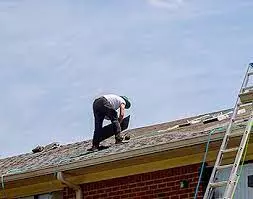In a world where climate change and environmental concerns are at the forefront of global conversations, finding sustainable solutions has become imperative. When it comes to protecting your home or business from the elements, choosing the right roofing material is crucial. One option that has gained popularity in recent years is metal roof. Not only does it provide a sleek and modern aesthetic, but it also offers a range of environmental advantages that are worth considering. From energy efficiency to long-term sustainability, metal roofing stands out as a responsible choice for those who prioritize both style and eco-friendliness. In this article, we will discuss some environmental advantages of metal roofing.
Benefits of Metal Roofing
Metal roofing refers to a construction technique that employs metal materials for the purpose of covering a building’s roof. This method has gained considerable prominence in the field of architecture due to its numerous advantageous features. Metal roofing systems are typically fabricated from materials such as steel, aluminum, zinc, or copper.
One key advantage of metal roofing lies in its exceptional durability and longevity. The inherent robustness of metal materials allows these roofs to withstand harsh environmental conditions, including extreme temperatures, heavy precipitation, and high winds. Additionally, metal roofs possess a remarkable resistance against corrosion and degradation caused by UV radiation or chemical exposure. This extended lifespan not only decreases maintenance expenses but also contributes to sustainable construction practices by reducing the frequency of roof replacements.
Environmental Advantages of Metal Roofing
A roof that not only protects your home from the elements but also helps save the planet. Metal roofing is revolutionizing the construction industry with its numerous environmental advantages.
It offers several significant environmental advantages that make it a superior choice for sustainable construction. Here are 5 key environmental advantages of metal roofs:
Long-lasting durability for reduced waste
The utilization of metal roofing systems offers a significant advantage in terms of extended durability, resulting in a notable reduction in waste generation. The inherent characteristics of metal roofs, such as their robustness and resilience, ensure that they maintain their structural integrity over an extensive period.
Metal roofs exhibit exceptional resistance against various environmental factors, including extreme weather conditions and ultraviolet radiation. This durability stems from the use of high-quality metallic materials designed to withstand external stresses and prevent deterioration over time. As a result, metal roofing systems demonstrate remarkable longevity compared to conventional roofing options like asphalt shingles or wooden shakes.
Energy efficiency for reduced carbon footprint
Metal roofing is highly energy-efficient, making it a sustainable option for homeowners seeking to reduce their carbon footprint. Metal roofs have excellent reflective properties, which means they can reflect a significant amount of solar radiation back into the atmosphere, preventing heat buildup in the home. This reduces the need for excessive air conditioning during hot summer months, reducing energy consumption and utility bills. Ultimately, lower energy use means fewer greenhouse gas emissions produced. Additionally, metal roofs can be installed with proper insulation, further enhancing their energy efficiency by preventing heat transfer between the interior and exterior of the building.
Recyclability
Metal roofing is highly recyclable at the end of its life cycle, making it an eco-friendly choice compared to other roofing materials that often end up in landfills. Metal roofs are commonly made from materials such as steel, aluminum, or copper. These metals can be easily melted down and reused in the production of new products.
The recyclability of metal roofing helps to reduce waste and conserve natural resources. By choosing a recyclable material like metal for their roofs, homeowners contribute to reducing the demand for mining raw materials. Extracting metals from mines consumes significant energy and has environmental impacts such as greenhouse gas emissions and habitat destruction. Recycling reduces these negative effects by providing a more sustainable source of raw materials.
Flame-resistant
Metal roofs have a naturally flame-resistant characteristic, making them an eco-friendly choice for homeowners concerned about fire safety. Unlike other roofing materials such as wood or asphalt shingles, which are highly flammable and can contribute to the rapid spread of fires, metal roofs provide a high level of protection against flames.
The fire resistance of metal roofs stems from the inherent properties of the metals used in their construction. Metals like steel or aluminum have high melting points and low combustibility, allowing them to withstand exposure to extreme heat without igniting. This makes metal roofs less prone to catching fire due to factors like sparks from nearby wildfires, stray fireworks, or ember showers during wildfires.
Rainwater Harvesting:
Another significant advantage of metal roofing is its suitability for rainwater harvesting systems. Metal roofs provide a smooth surface with no organic compounds that could contaminate water collected from rainfall runoff. The rainwater collected from these roofs can be used for various non-potable purposes, such as irrigation, toilet flushing, or laundry. By implementing rainwater harvesting systems, homeowners can reduce their reliance on treated water sources, conserve valuable freshwater resources, and lower their utility bills.
In conclusion, metal roofing represents an innovative solution for constructing resilient and environmentally conscious roofs.The production of metal roofing has become increasingly environmentally friendly over the years. Metal roofs can be equipped with solar panels, further reducing reliance on fossil fuels and harnessing clean energy from the sun. Many manufacturers now use recycled materials in the production of metal roofing panels. It reduces the need for raw materials consumption and energy-intensive extraction processes. To make a positive impact on the environment while enjoying the benefits of a long-lasting roof, consider choosing metal for your next roofing project.




